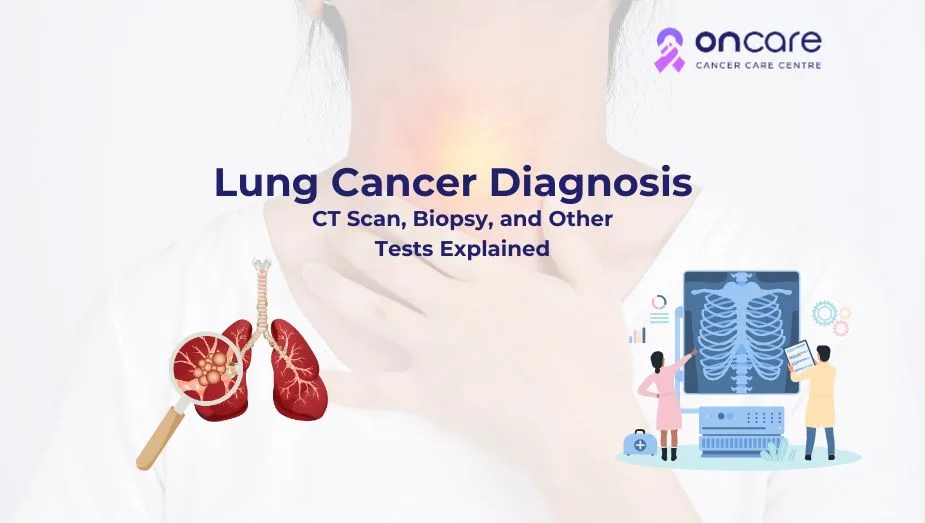Table of Contents
Lung Cancer Diagnosis: CT Scan, Biopsy, and Other Tests Explained

Lung cancer is one of the most life-threatening and common cancers in the world. Early lung cancer diagnosis plays a key role in improving the overall survival rates and guiding effective cancer treatment. If you are concerned with how lung cancer gets diagnosed and what tests doctors do to confirm the presence of cancer in lungs, then read further!
In this blog, we’ll look more into different types of diagnostic methods used to detect lung cancer, including CT scans, imaging tests, biopsies, and other important tests.
What are the tests performed to diagnose lung cancer?
A healthcare professional might perform different types of tests that include blood tests, biopsies, imaging tests, CT scans, and much more.
Here are some of the tests and scans used to diagnose these conditions.
These may include:
Blood tests
Performing blood tests can’t diagnose any types of cancer alone. Meanwhile, it can help the oncology team to check how lungs and other organs work.
It can also check factors such as:
- Liver and kidney functions
- Blood count levels
- Tumor markers (including CEA and CYFRA-21)
Biopsy
To confirm the presence of cancer in the lungs, most of the time doctors perform a biopsy, which includes collecting sample tissues from a suspected patient under a microscope.
There are different types of biopsies and tests are used to diagnose cancer in the lungs.
These may include:
- Needle biopsy (CT-guided): Needle biopsy with CT guided scan helps to guide and analyze the lung in this procedure. A doctor usually inserts it through the chest wall into the lung to collect a tissue sample for the cancer diagnosis.
- Bronchoscopy: This is a minimally invasive medical procedure that helps the oncological team to check inside the airways and lungs with a bronchoscope. This is a thin tube with a light and camera on it. It helps to diagnose, evaluate, and sometimes treat conditions that affect the lungs, trachea, or throat.
- Thoracoscopy: A thoracoscopy is a medical procedure used to analyze and diagnose issues in the lungs and other organs in the chest. An oncologist uses a thoracoscope to collect samples of lung tissue or lymph nodes. It consists of a thin camera with a light, which helps to see the diaphragm, esophagus, chest wall, and other areas of the chest.
Biopsies and other tests can help to determine the type of cancer developed in suspected cancer patients. Performing these tests helps to detect cancers such as small cell lung cancer and non-small cell lung cancer and their aggressiveness in people.
CT Scan
A CT scan is usually the first imaging test used when cancer is suspected in patients. It provides detailed cross-sectional images of the lungs. It often helps to diagnose lung diseases and detect any abnormal growths or lobules.
Why are these tests important?
- It detects lung tumors that are often too small for regular X-rays.
- It helps to reveal the size, shape, and position of suspicious tumors or masses.
- It can help assess whether cancer has spread to the nearby tissues in the lungs.
A medical team might perform a low-dose CT scan for cancer screening in high-risk individuals who have excessive smoking habits above the age group of 50+.
PET scan
A Positron Emission Test (PET) scan detects active cancer cells in the lungs and sometimes cancer cells present in the body. A healthcare practitioner might inject radioactive sugar into the bloodstream. The cancer cells often absorb this type of sugar more than the normal cells, which helps to light them up during the scan.
Why is this done?
- These tests are used to stage cancer.
- It is also used to check whether the cancer has started to spread to lymph nodes or distant organs.
- It helps to decide if surgery is possible in suspected patients.
MRIs and Bone scans
A medical team usually suggests the MRIs and bone scans when they suspect the cancer has spread to the brain and bones; they may include:
- MRIs: MRIs and bone scans are mostly used to diagnose bone metastasis in lungs. The MRIs are generally considered more sensitive, especially for early diagnosis of lesions and surrounding soft tissue involvement in the lungs.
- Bone scans: This is also known as bone scintigraphy, and is valuable for diagnosing bone metastasis, but MRIs provide more detailed images of bone marrow and other surrounding structures.
Molecular testing
Once cancer gets confirmed in a patient, especially in non-small cell lung cancer, then a tissue sample might be sent for genetic or molecular testing. These molecular tests can guide targeted therapy or immunotherapy.
It helps to identify genetic mutations such as:
- EGFR
- ALK
- KRAS
- ROS1
Chest X-ray
A chest X-ray is often considered the first test to be performed to diagnose cancer in the lungs. Most times, studies suggest that long tumors might appear on the X-rays as a white-grey mass.
A chest X-ray can’t give any perfect diagnosis because it can’t differentiate between cancer and other conditions, such as lung abscess, which is a situation that is a collection of pus that forms in the lungs.
Consult Today
Lung cancer diagnosis usually involves a combination of treatments, including imaging, biopsy, and blood tests. Studies suggest that these diagnostic tools confirm the cancer, its stage and extent, and help to create a more personalized treatment plan.
At Oncare, we offer quality cancer treatments including cancer surgeries at affordable price ranges with an experienced cancer specialist consultation.
If you or any loved ones of yours are diagnosed with cancer, then visit Oncare Cancer Center and book an appointment with our cancer specialists. Get an estimated cost of cancer treatments today!
Frequently Asked Questions
The symptoms of lung cancer may include:
- A cough that doesn’t go away or worsen over time
- Shortness of breath
- Chest pain
- Discomfort
- Wheezing
- Coughing up blood
- Hoarseness
- Loss of appetite
- Sudden weight loss
- Extreme fatigue or tiredness
- Shoulder pain
- Swelling of the pain, neck, arms or neck
- Horner’s syndrome
There are some risk factors of lung cancer, these may include:
- Being exposed to secondhand tobacco smoke
- Being exposed to harmful substances such as radon, asbestos, uranium, and diesel exhaust
- Previous treatment history of the chest (breast cancer or lymphoma)
- Having a family history of lung cancer
There are some tests and scanning methods that are used to perform on suspected patients. These may include
- Blood tests
- Biopsies
- Imaging
- Molecular tests
Here are some treatments used for this type of cancer, these may include:
- Surgery
- Radiofrequency ablation
- Radiation therapy
- Chemotherapy
- Targeted therapy
- Immunotherapy

